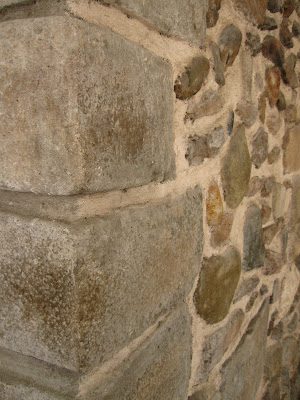This is the first of a series of blog posts I'll be writing about our recent trip to Ecuador. It’s hard to believe that we spent three weeks there, though looking back I honestly can’t decide whether if felt like only a few days or a lifetime. Enjoyable in a traditional sense is not the first word I would use to describe the trip, but no doubt it was a memorable experience. Other words that come immediately to mind are colorful, thrilling, perspective-altering, joyful, relaxing and intimidating. We visited three different locations along 300 miles of the Andes Mountains between 5,000-10,000 feet. After meeting up with our friends Keith and Liz in Quito, we flew down south to the historic city of Cuenca, and then spent an additional week with them traveling around the Quito area. Finally, Peter and I headed off on our own for a week in Otavalo. During our trip we learned a great deal about the history and biodiversity of the country, but as time went by I began to realize that all the known facts about Ecuador only scratch the surface of understanding its diverse cultures. In my blog posts I will attempt to capture the sights and sounds of Ecuador as I experienced them...

We studied Spanish for a week at the Simon Bolivar Spanish School in Cuenca, a city of a half million people that has been designated a UNESCO world heritage site for its well-preserved 16th century Spanish colonial architecture. We stayed with a wonderful woman named Elena in her hillside home above the city. Every day for a week, our lives followed a fairly predictable pattern – fortified by a breakfast of scrambled eggs, juice and coffee we joined the throngs of business people and students for our twenty minute walk downtown. Across the busy streets, past the house with the flock of chickens in the yard, sidestepping the street vendors and crowds waiting at the bus stop until finally we ducked through the doors of the school where I ascended the four flights of creaky wooden stairs to a tiny whitewashed classroom with a narrow wooden table and three chairs. If our teacher hadn’t arrived yet, I would take a moment to throw open the window and let the sunshine in as I gazed across the rippling ocean of rooftops punctuated by steeple spires. After four hours of class we returned home for lunch, and then back to the city for the rest of the day and evening to explore.


Worlds collide when you stroll through the historic city center of Cuenca. Everywhere you look gracefully embellished pastel colored buildings topped with terracotta tiles line the cobbled streets. Down at street level, electronics stores display an assortment of flat screen televisions where passersby occasionally congregate to watch soccer games and boxing matches. Native Ecuadorian women in their colorful skirts and distinctive hats walk alongside teenagers dressed in the latest fashions. Cars and buses barrel down the narrow streets belching black exhaust, their mechanical noises echoing off ancient walls.


The city is graced with more than fifty beautiful churches. The layers of complex history in Cuenca are most apparent in its oldest church, Iglesia del Sagrario, constructed in 1567. An intentionally exposed section of the foundation reveals massive rectangular stones taken by the Spanish architects from disassembled Incan temples in the area. Repairs to the walls and floors throughout the centuries have uncovered untold numbers of hidden frescos, catacombs, and alcoves masked by a succession of aesthetic and functional alterations. Symbolic bridges abound in the architecture, décor and artistic works displayed in churches across Ecuador. The sun and moon were most commonly incorporated as a way to connect Christian and Incan beliefs. Famous historical paintings depicted llamas present at the birth of Jesus and guinea pig, a native staple, being eaten at the last supper.



Directly across the square from Iglesia del Sagrario is the “new” cathedral, constructed over the course of a century beginning in 1885. Gorgeous swirls of coral, gray and cream marble flow across the floors, up walls and around the curves of massive structural columns. Light reflects luminously off the gilded high alter as it streams through the stained glass windows. Czechoslovakian tiles grace the ethereal blue domes that have become the focal point of the city. Every detail reflects an expression of power.



While there are supermarkets scattered around the city, Cuenca also has a variety of colorful specialty mercados where vendors sell everything from flowers and food to clothing, crafts and household goods. The variety of vendors and services fluctuate daily. Twice a week, curanderas are available at the craft market to treat general maladies attributed to “bad energy”. These specially trained healers provide a cleansing treatment to remove the offending negativity, thereby increasing an individual’s chance of improved health and well being.



An hour south of the city is El Parque Nacional Cajas, an undulating high elevation landscape of peaks and lakes that preserves rare flora and fauna, including ancient miniature forests and the nation’s only bear species. While we were blessed with a sunny, wind-free day it was easy to perceive the forbidding nature of less pleasant weather waiting patiently for the opportune moment to return. Before the highway between Cuenca and the coast existed, the trek was made at great peril by horseback. Just outside the park entrance, La Casa Vieja (the old house) has served as a refuge for travelers in this area for more than sixty years. The third generation of family still operates a restaurant serving traditional Ecuadorian food and fresh farmed trout. We had a lunchtime feast in the adobe home with a fire to take the chill out of the air as Elena’s neighbor Diego, our guide for the day, elaborated with pride about the historic importance of the place and the decades of travelers who had eaten the same types of food at our very table.



I will not soon forget the experiences we had in Cuenca during the first week of our trip. This genteel city provided a soft place to land, a thorough review of the Spanish language and an excellent introduction to such a beautiful and complex country. From this solid foundation we would launch off to the intense urban sprawl of Quito and then to the more rural northern areas of Mindo and Otavalo. To be continued…












































 The olive groves are in "bloom" right now, which may not appear very spectacular from the highway, but close up the flowers have their own unique beauty.
The olive groves are in "bloom" right now, which may not appear very spectacular from the highway, but close up the flowers have their own unique beauty.








